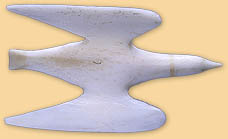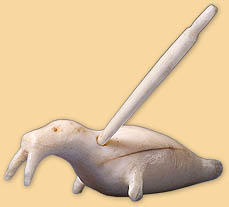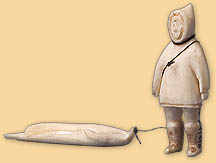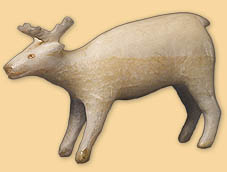 |
In 1965, the CMC received a collection of ivories from Labrador
which were in the possession of Mrs. A. W. Wakefield of Cumberland,
England. In the notes which accompanied the small collection, she
mentions her husband, Dr. Wakefield, and his regular winter trips
from Battle Harbour to Cape Chidley, Labrador. Dr. Wakefield was a
medical doctor who was in charge of the Grenfell mission at St.
Anthony.* Before that, he was at the mission in Battle Harbour.**
The Wakefields were in Labrador from 1908 to 1914.
About the ivories Mrs. Wakefield recalls: "These were carved
from walrus tusks by an Eskimo boy at Hebron. His only tool was a
small piece of flint. I bought them in 1912. The saw is especially
beautiful."***
*He is mentioned in "Archibald the Arctic" by
Bishop Fleming on page 41.
**
www.frontiersmen.org.au/newfoundland.htm
*** CMC Archives (collectors' files)

 |
Bird in Flight, 1912
Hebron, Labrador
Ivory
0.5 x 3.5 x 2 cm
CMC IV-B-1147
Collected by Mrs. Marjorie Wakefield, wife of Dr. A. W. Wakefield,
while stationed at Grenfell missions in Labrador
|
 |
It is remarkable that this tiny sculpture was carved with as crude
a tool as a small flint. The delicate ring around the bird's neck has
been added with brown colouring.
Exhibition History:
Sculpture/Inuit: Masterworks of the Canadian Arctic.
Organized by the Canadian Eskimo Arts Council. Vancouver Art Gallery,
Vancouver, B.C., November 9 – December 9, 1971; Le Grand Palais, Paris,
France, February 10 – April 2, 1972; Nationalmuseet, Copenhagen, Denmark,
April 26 – May 28, 1972; The Hermitage, Leningrad, Russia, June 29 –
July 23, 1972; Pushkin Fine Arts Museum, Moscow, Russia, August 10 –
September 10, 1972; Burlington Gardens Museum, London, England,
October 5 – December 10, 1972; Philadelphia Museum of Art, Philadelphia,
U.S., January 24 – March 4, 1973; National Gallery of Canada, Ottawa,
May 17 – June 17, 1973.
Arctic Mirror. Canadian Museum of Civilization, Hull, Quebec
January 25 – September 9, 1990. No catalogue.
Reference:
Canadian Eskimo Arts Council
1971 – Sculpture/Inuit. Exhibition Catalogue. Ottawa:
Canadian Eskimo Arts Council. No. 73.
Harpooned Walrus, 1912
Hebron, Labrador
Ivory
4.3 x 1.5 x 1 cm
CMC IV-B-1143
Collected by Mrs. Marjorie Wakefield, wife of Dr. A. W. Wakefield,
while stationed at Grenfell missions in Labrador
|
 |
 |
The harpoon adds a narrative element, telling a story rather than
presenting the animal in isolation. Unusually, the tusks have been
carved out of the same piece of ivory as the rest of the sculpture.
Exhibition History:
Sculpture/Inuit: Masterworks of the Canadian Arctic.
Organized by the Canadian Eskimo Arts Council. Vancouver Art Gallery,
Vancouver, B.C., November 9 – December 9, 1971; Le Grand Palais, Paris,
France, February 10 – April 2, 1972; Nationalmuseet, Copenhagen, Denmark,
April 26 – May 28, 1972; The Hermitage, Leningrad, Russia, June 29 –
July 23, 1972; Pushkin Fine Arts Museum, Moscow, Russia, August 10 –
September 10, 1972; Burlington Gardens Museum, London, England,
October 5 – December 10, 1972; Philadelphia Museum of Art,
Philadelphia, U.S., January 24 – March 4, 1973; National Gallery of
Canada, Ottawa, May 17 – June 17, 1973.
Reference:
Canadian Eskimo Arts Council
1971 – Sculpture/Inuit. Exhibition Catalogue. Ottawa:
Canadian Eskimo Arts Council. No. 83.
 |
Hunter Hauling Seal, 1912
Hebron, Labrador
Ivory, black cotton string, brown colouring
Hunter: 4.5 x 2 x 0.5 cm
Seal: 0.5 x 4.5 x 1.2 cm
CMC IV-B-1141
Collected by Mrs. Marjorie Wakefield, wife of Dr. A. W. Wakefield,
while stationed at Grenfell missions in Labrador
|
 |
The diminutive figure is perfectly balanced and can stand on its
own, without support. Brown colouring has been applied to suggest the
texture of the sealskin boots.
Caribou, 1912
Hebron, Labrador
Ivory, black and brown colouring
2.2 x 3.5 x 0.7 cm
CMC IV-B-1149
Collected by Mrs. Marjorie Wakefield, wife of Dr. A. W. Wakefield,
while stationed at Grenfell missions in Labrador
|
 |
 |
As with the tusks of the walrus by the same artist, the antlers of
this minuscule caribou grow right out of the same piece of ivory. This
seems to be typical for Labrador carvings generally. Other regions
tend to carve the horns out of genuine caribou antler, and peg them
on to the carving.
|